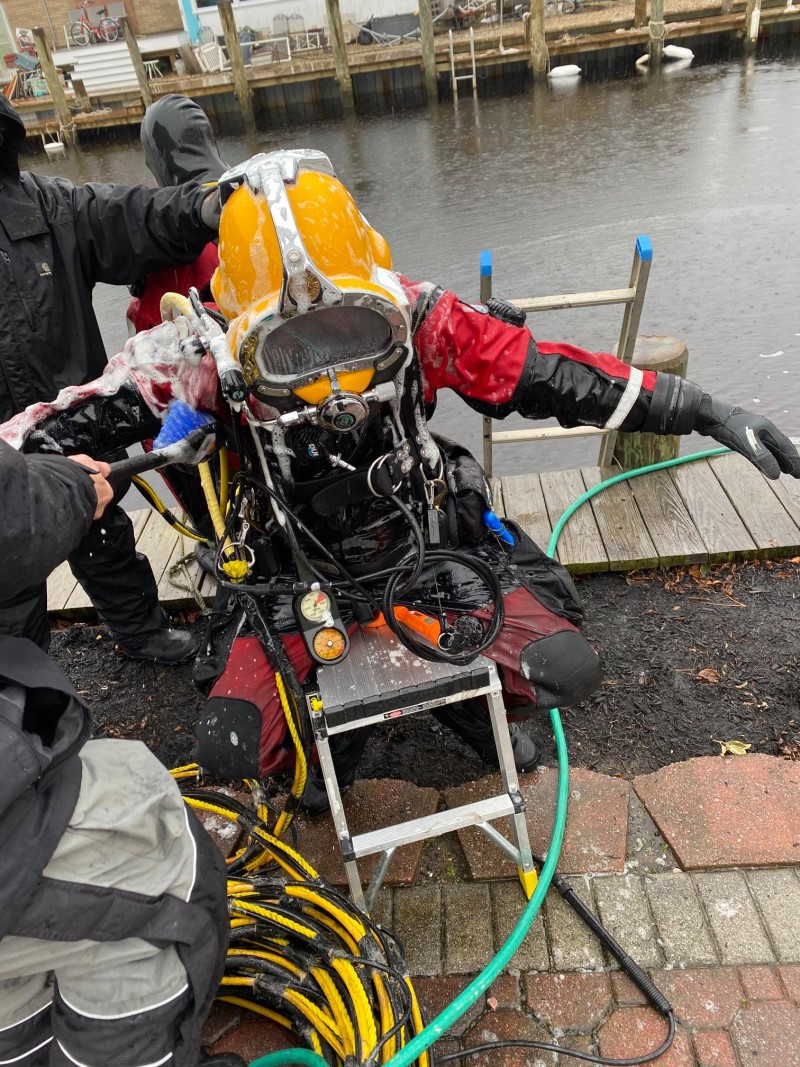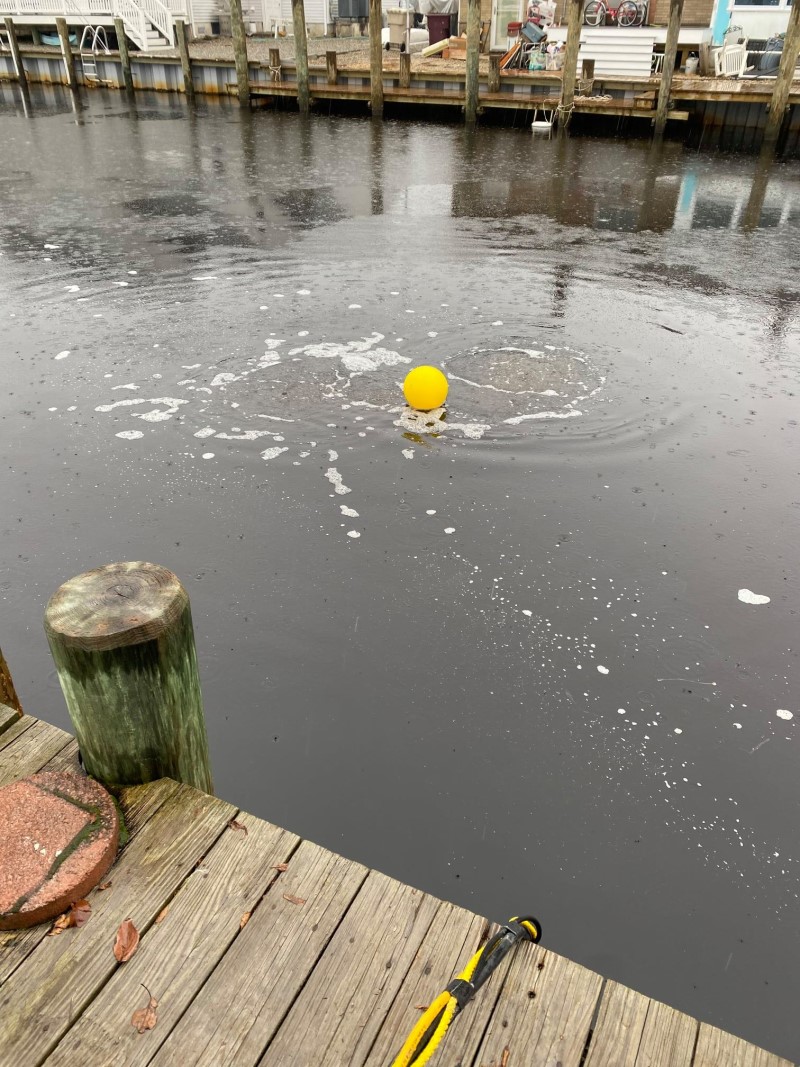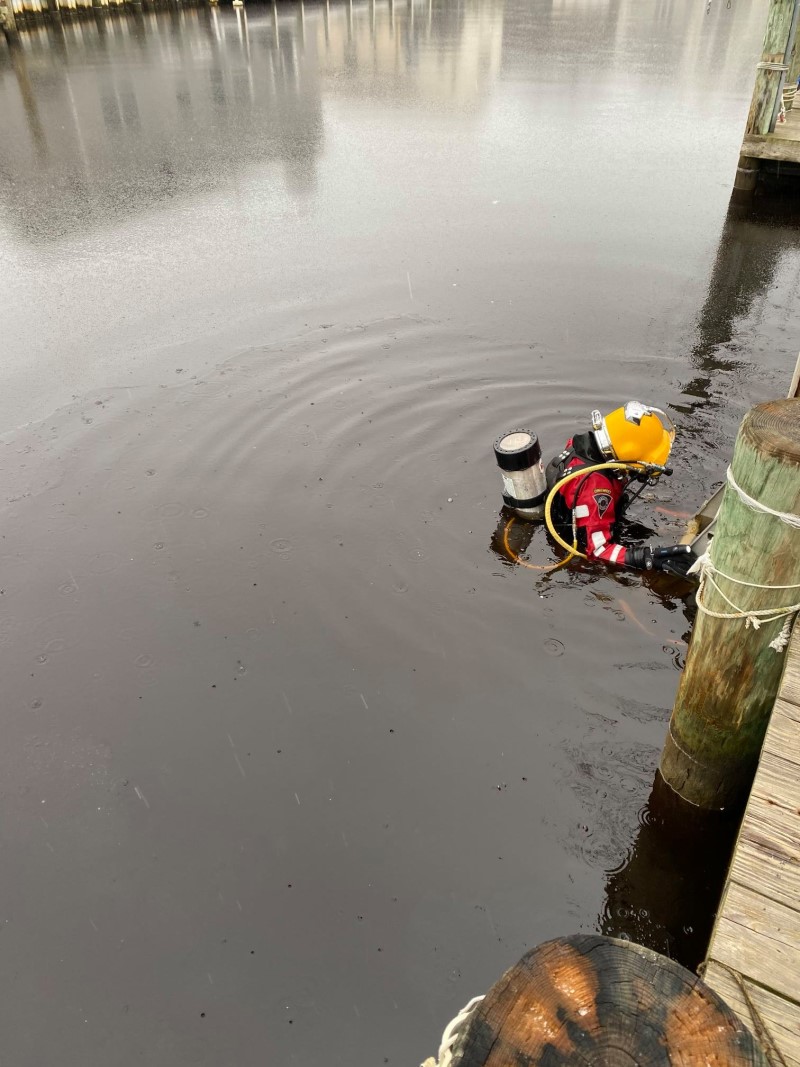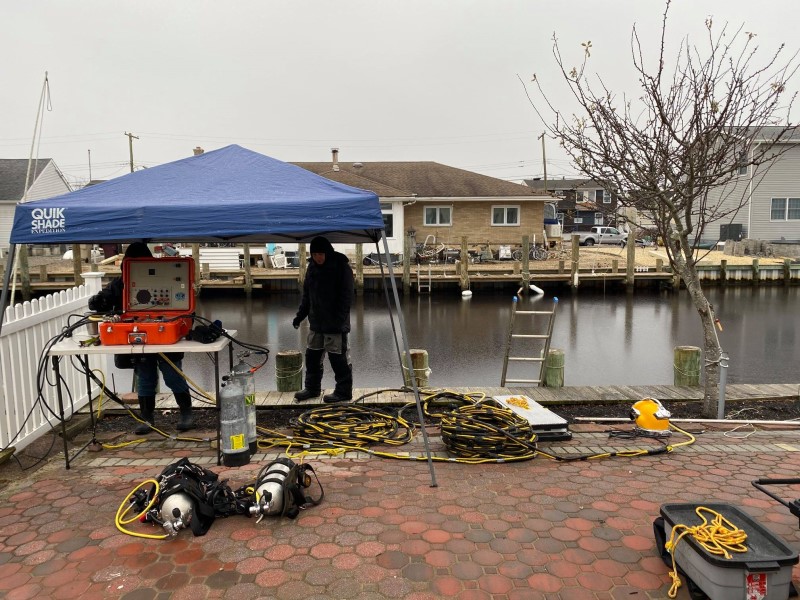A few days ago, a NJ resident, Dominick J Vieira, reached out to the divers of the NJ Dive group asking if there were any divers willing to search for his missing wedding ring. As Dominick explained, his ring flew off his finger while he was attempting to lash his late father’s boat to his boat, on the lagoon behind his father’s house.
Dominick wasn’t sure where the ring went, as it flew off his finger behind him and pinged off the railing of his boat. After thoroughly searching his boat, Dominick came to the conclusion that the ring must have fallen in the lagoon somewhere near the boats.
After considering the difficulty of the search (very small item, near blackwater, and unknown bottom conditions) we offered to assist Dominick using the same techniques we use and teach in the field.
This morning, our staff divers arrived at the location at 9am and began setting up for the operation.
We closely interviewed Dominick and his neighbor to get the best possible determination of where the ring might have landed (since no one witnessed it hitting the water), and even had Dominick draw us a series of drawings depicting where his, and his father’s boat, were situated when the ring flew off. We then had Dominick compare the drawings to the actual physical spot in question to confirm we were in the right location.
Because of the size of the object we were seeking, we elected to use a single line Jackstay search manned by two divers working in overlapping patterns.
The lagoon was depth-sounded, the jackstay was prepared, and a 20′ search length was chosen and set up. We then deployed the jackstay starting at the bulkhead covering the area Dominick indicated.
While final preparations were being made, a single diver made a pass over the area to visually search for the object and assess bottom conditions.
Water depth was 11-13′, water temperature was 41-degrees on the bottom, slack tide, and visibility was roughly 1 foot with a can light without disturbing the silt layer. No ring was located in this visual passes.
At this point, Diver two joined Diver one (both divers were on surface supplied air and voice comms. One wearing a hardhat, the other wearing a full face mask.) Diver one hand searched ahead of Diver two, who re-searched the same area using an underwater metal detector set on the highest sensitivity.
Once searching started, visibility dropped to blackwater (even blacking out the can lights completely) and we quickly realized the silt layer was approximately a foot deep of baby-powder consistency and littered with rocks, sticks, and construction debris including large panes of window glass (some broken in shards and some fully intact) and buckets full of discarded nails.
Both divers completed five full passes, moving the jackstay roughly 16-24″ between passes and searching inches at a time. Total search time for this dive was 105 minutes, 11-13′, 41-degrees, with overlapping search patterns (each diver searched the same area twice).
Having cleared this section of the search area, and being a bit cold, both divers returned to the surface to warm up and get some coffee. Upon surfacing, topside told the divers that they noticed an obvious oil sheen bubbling up from the bottom while both divers were working. Because of this, both divers were fully decontaminated according to our procedures before they removed their masks and came off air.
The next phase of the operation involved a new diver hand searching the bulkhead area, inches at a time. Over the course of a 40 minute dive, this diver cleared approximately 15′ of bulkhead.
Our final phase of the operation was diver one (of the first search) returning to the original search area on SCUBA and re-searching two passes of the outside of the first search zone with a metal detector to cover the edges of the zone where the original searching divers were turning around. During this dive, diver one experienced a catastrophic failure of their pony regulator (the clip choker walked down to the regulator and unscrewed it while the diver was working, causing the regulator to shoot off the hose and send the hose whipping through the water, open flow), which prompted a temporary stoppage to the operation. Once that issue was corrected and the lost regulator recovered, searching resumed.
After clearing the turn points, we determined that this search sector was sufficiently cleared and the jackstay was retrieved. Dive time, 40 minutes, 13′, 41-degrees, blackwater conditions. Silt conditions near the center of the channel deepened to nearly two feet of baby-powder oily black silt.
After the diver was retrieved and properly decontaminated, the operation was broken down and cleaned up.
We departed the dive site at 3pm, having cleared one search zone without locating the missing ring, exhausting all of our available air and concluding that we would return to search the remaining search zones.
All told, three divers completed a cumulative 290 minutes of bottom time (4 hours and 50 minutes), at 41-degrees, where they thoroughly searched a 20×15′ zone of high probability.
Despite us not locating his ring this time, Dominick was more than pleased with our efforts and we have made plans to return to the site in the very near future and search the remaining sectors of probability. As we told Dominick, if his ring is in there, we will make EVERY effort to find it. Even if it takes multiple trips.
At the end of the day, we departed somewhat downtrodden but happy that we could definitely say “that area is clear.”
Later that afternoon, Dominick posted the following on Facebook:
I would like to give a shout out to the crew from North East Public Safety Divers, they showed up on Sunday around 9.00am and began setting up their equipment and I quickly saw these guys are professionals at what they do.
Weather conditions weren’t best with ice cold rain and around 30 degree temperatures.
This lagoon is a dead end with approx 12ft depth along sides and 15 ft in center.
The water is brackish and almost black at times .
First team went in and worked the area I believe the ring fell in but conditions were rough with debris field, large glass panes, tons of nails from bulkhead workers and black silt up to their elbows not to mention zero visibility.
I gained alot of respect for this crew and any other divers that work under these conditions. I can’t thank them enough for the hard work they endured Sunday.
This dive didn’t turn up the ring with day getting short fast but the guys are telling me they want to go at it again in near future.
As the hours went by , while the divers were down in the water, I began to feel less sentiment for the ring, and instead ,I wanted them to find it so their hard work would be rewarded and they could come up from the cold waters. These guys are a tough dedicated group. They don’t give up.
I really want to thank these men for the hard work they did yesterday. I learned alot watching the operation.
And I want to thank all those who gave me well wishes.
Thank you
I used to think my father having been a Portuguese doryman fishing the north Atlantic was from the days when ships were made of wood and men were made of iron. This past Sunday I met some more of those iron men.
Once again, thank you all.





